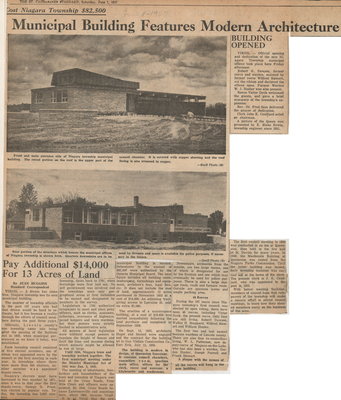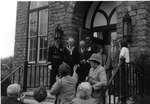BUILDING OPENED
VIRGIL — Official opening and dedication of the new Niagara Township municipal offices took place here Friday afternoon.
Robert G. Dawson, former reeve and warden, assisted by former reeve Wilfred Stewart, cut the ribbon and declared the offices open. Former Warden W. J. Hunter was also present.
Reeve Victor Dyck welcomed the guests, and gave a brief summary of the township's expansion.
Rev. Dr. Fred Sass delivered the prayer of dedication.
Clerk John K. Couillard acted as chairman.
A picture of the Queen was presented by E. Blake Erwin, township engineer since 1931.
The first council meeting in 1850 was conducted in an inn at Queenston, then held in the fire hall at St. Davids for many years. In 1950, the Mackenzie Building at Queenston was rented from the Niagara Parks Commission. Until the latter building was leased, daily township business was carried out at the home of the clerk. The present clerk is J. K. Couillard, who was appointed to the post in 1953.
With better meeting facilities, members of council hope that rate-payers of the township will make a sincere effort to attend council meetings, to learn how their elected members carry on the business of the area.
"Municipal Building Features Modern Architecture"
VIRGIL — A dream has come} true. Niagara township has its own municipal building.
The number of township officials in the past 107 years who had that dream would be hard to estimate, but it has become a reality through the efforts of council members during the past three years.
Officially, Lincoln county's one township came into being after the passing of the Baldwin Act in 1849, when municipal government as we know it today, was established.
Each township council consisted of five elected members, one of whom was appointed reeve by the council at the first meeting in each year. In townships where there were more than 500 electors, another member was appointed deputy-reeve.
Niagara's electors must have increased to that number by 1871, since it was in that year the first deputy-reeve, George D. Prest, was elected by popular vote. Today, the township has 2,837 electors.
Actually, Niagara's history as a township, dates back to 1791, when townships were first laid out. No self government was involved and the townships were only geographical areas at first forbidden to be named and designated by numbers in the survey. Legislature in 1793 authorized ratepayers to meet and elect petty officers, such as clerks, assessors, collectors, overseers of highways, pound keepers and town wardens, but their powers were strictly limited to administrative acts. All powers of local legislation were withheld except powers to regulate the height of fences and limit the time and seasons during which animals might be allowed to run at large.
Until 1850, Niagara town and township worked together. The first municipal meeting under the District Municipal Act of 1841 was Jan. 3, 1842. The meeting of inhabitants, freeholders and householders of the town and township of Niagara was held at the Cross Roads, Four Mile Creek and officers were appointed. By 1846, Cross Roads became Lawrenceville and sometime later, about 1863, became Virgil. It is at Virgil that the new municipal building is located.. Debentures in the amount of $82,500* were authorized by the Ontario Municipal Board. The total figure includes all building costs, landscaping, furnishings and equipment, architect's fees, legal fees, etc. It does not include the cost of land, approximately 13 acres purchased in November 1955 at a cost of $14,000. An adjoining tract, giving access to Lorraine St. cost an extra $1,000.
The erection of a maintenance building, at a cost of $19,856 was started immediately following the land purchase and completed in September. 1956.
On Sept. 12, 1955, architects Huget and Secord were engaged and the contract for the building let to Guy Violino Construction Co Fort Erie, July 12, 1956.
The building is modern in design, of Queenston limestone. It contains council chambers, committee room, spacious main office, offices for the clerk, reeve and assessor, a kitchenette and washrooms.
Downstairs, accessible from the outside, are two large rooms, one of which is designated for use by the firemen and one which may eventually be used for police purposes. There is also a large storage room, vault and furnace room. Outside are spacious lawns and ample parking area.
40 REEVES
During the 107 years since Niagara township's first council was elected by open voting, there have been 40 reeves, including Victor Dyck, the present reeve. Only four are still living, Robert Dawson, Walter H. Sheppard, Wilfred Stewart and William Hunter.
The first two and last named became wardens of Lincoln county. There are also four ex-councillors living, W. L. Patterson, now deputy-reeve of Niagara-on-the-Lake, who has also been a warden, Gordon Hunter, Joseph Parnell and Frank Stewart.
A plaque with the names of all the reeves will hang in the new building.




